Excerpts from Jim Conrad's
Naturalist Newsletter
Entry dated March 28, 2024, issued from near Tequisquiapan; elevation about 1,900m, (6200 ft), ~N20.57°, ~W99.89°; Querétaro state, MÉXICO
BONPLAND WILLOW WITH FEMALE CATKINS
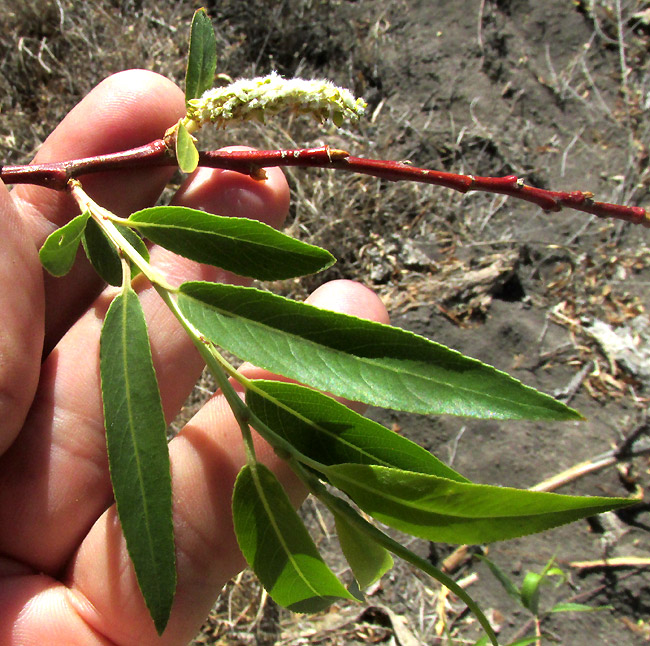
Despite this being the normal dry period during an ongoing two-year weather pattern categorized by the North American Drought Monitor as a D3 Extreme Drought, willows are flowering. Above, a catkin of mature, capsule-type fruits is releasing tiny seeds surrounded by long, silky hairs, which enable the seeds to parachute elsewhere on the wind. Willows usually produce male flowers on one tree, and female ones on another.
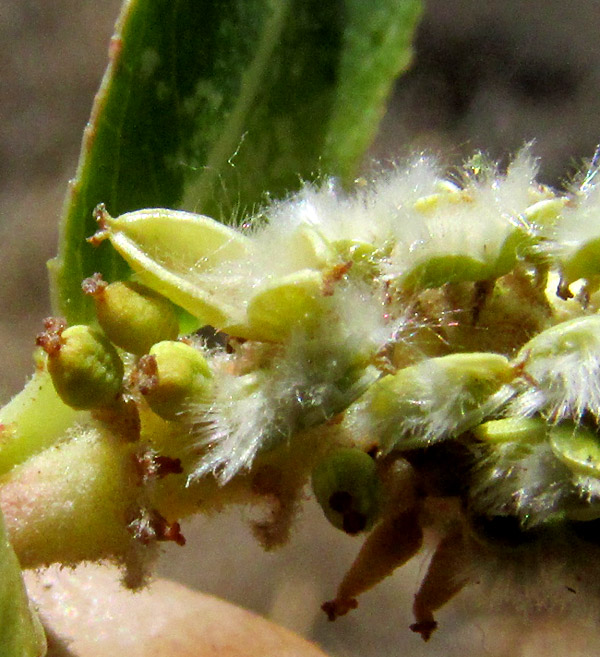
In the above close-up, several less mature capsules remain closed, each topped with two brown, two-lobed stigmas. Other capsules have split wide open and are in the process of disseminating their hair-enshrouded seeds.
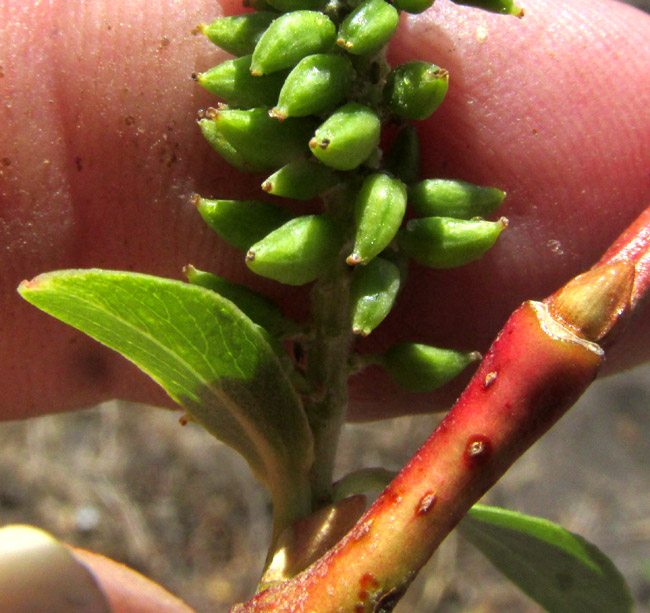
On the same tree, some catkins bore only immature capsules. Note the stem's reddish color, the bud ready to sprout later, and conspicuous pores, the lenticels, allowing gas exchange between the atmosphere and the stem's internal tissue.
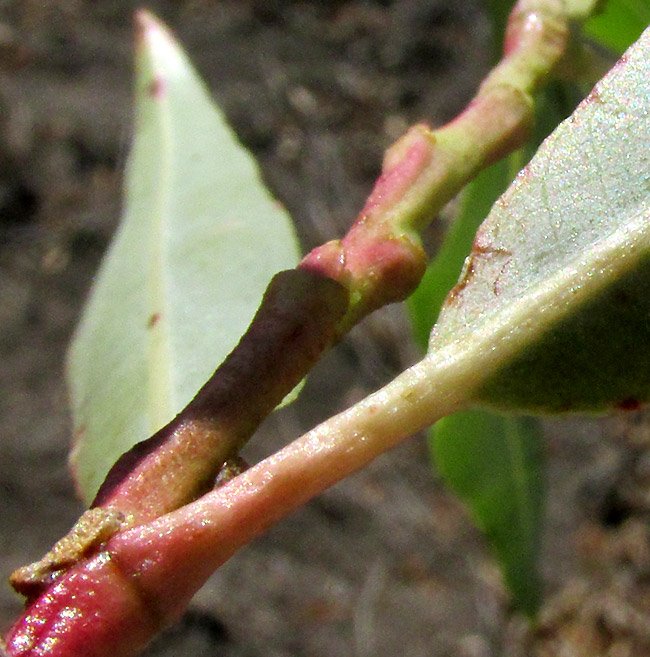
Leaves were hairless and leaf undersurfaces were silvery, contrasting with their green tops.
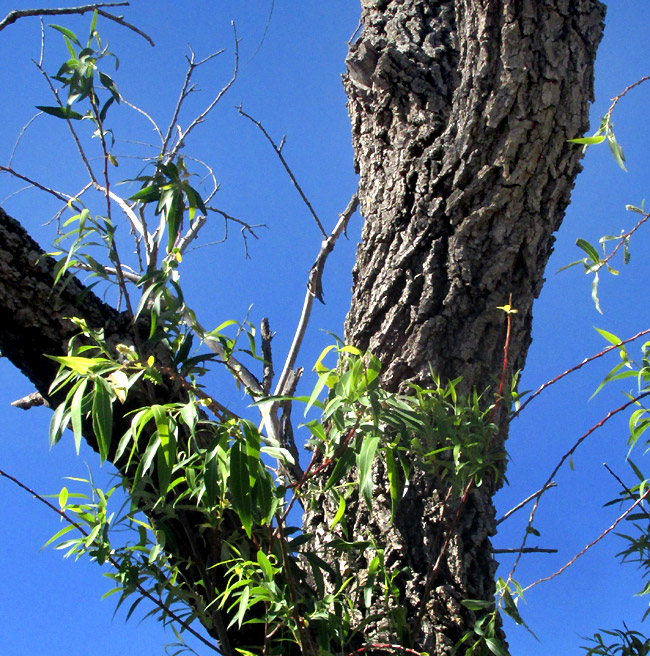
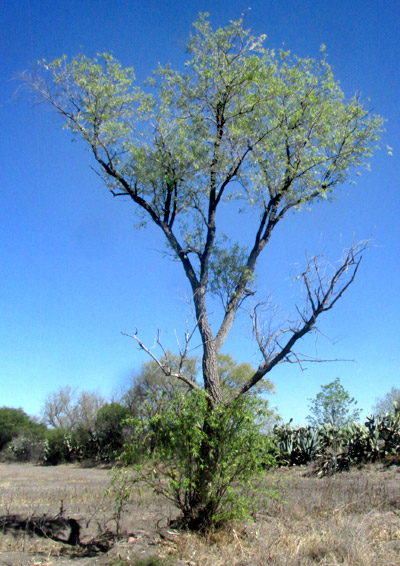
The tree's bark was blackish and deeply furrowed. As seen at the right, the tree had been severely damaged, with several major branches dying. Judging from debarking on the trunk, the whole tree may have been uprooted and moved with a machine a short distance, where it took root again and issued vigorous new sprouts from the base. It stood only about ten meters (~30ft) from an artificial pond kept filled with irrigation runoff, and this enabled our resilient tree to survive in an otherwise willowless landscape.
The Moravian German Jesuit missionary assigned to northern Mexico and now known as Juan de Esteyneffer wrote in his Florilegio Medicinal of 1712 that indigenous Mexicans used the Bonpland Willow medicinally for head problems, hemorrhoids, childbirth illnesses, fevers, herpes, scabies and warts. The online Atlas de las Plantas de la Medicina Tradicional Mexicana says that the old use for fevers persists today. Willow species in general have been used medicinally at least since the ancient Assyrians and Sumarians. Wikipedia provides an extensive entry on the history of willow's medicinal uses. That information indicates that willow-based products may produce only the mildest analgesic effects.
In this part of upland central Mexico known as the Bajío, six willow species, genus Salix, have been documented. In our area, if your willow is a tree instead of a shrub, and its newest stems and leaf undersurfaces are hairless, you have SALIX BONPLANDIANA, the Bonpland Willow.
Bonpland Willows occur throughout Mexico's western, central and southern uplands, into Guatemala. A separate population appears in central and southeastern Arizona in the US, accounting for the English name.
This is yet another species introduced to science by the collections of Humboldt and Bonpland during their explorations of Mexico during 1803 and 1804. The species was published by Kunth in 1817, along with the collectors' field notes: "Crescit in regno Mexicano locis opacatis propre Moran, Cabrera, Omitlan et Pachuca, alt. 1270-1350 hexap. Floret Majo -- "It grows in the Mexican kingdom in shady places of Moran, Cabrera, Omitlan and Pachuca, alt. 1270-1350m. Blossoms in May."
A similar willow species also occurring in Querétaro is named after Humboldt, Salix humboldtiana, but it was collected when the scientists were in Peru. That species is mostly South American, but extends north through Central America and Mexico.
from the March 3, 2007 Newsletter issued from Sierra Gorda Biosphere Reserve, in Jalpan de Serra; N21.23°, W99.47°, elevation ~800m (~2600ft); QUERÉTARO, MÉXICO
BONPLAND WILLOWS FLOWERING
On Sunday morning I hiked around the reservoir again. It's a perfect hike, taking about three hours if you're in a rush, about five if you gawk at things. Here and there small marshes have developed along the shores of this manmade reservoir. As you might expect, water-loving willows are prominent among the woody species. Those willows are flowering now. You can see a summery-looking picture of male willow catkins below:

This is the Bonpland Willow, SALIX BONPLANDIANA, distributed from Arizona and New Mexico through all of Mexico into Guatemala. Among the 450 or so willow species, Bonpland Willows are somewhat unique in that instead of being early deciduous in the fall like most willows they drop their leaves irregularly throughout the winter dry season. Ours have passed through their leaf-dropping and you can see how fresh and so-far-un-bug-eaten the new leaves look.
In the shadowy, cool cove where I took that picture, Northern Parula warblers were calling their heads off, reminding me sharply of early spring days back in Mississippi when parulas were the first warblers to announce spring with real vigor.